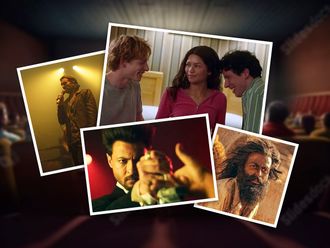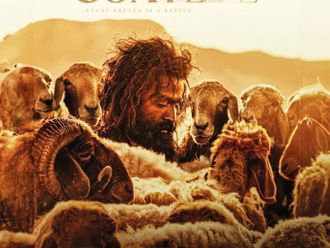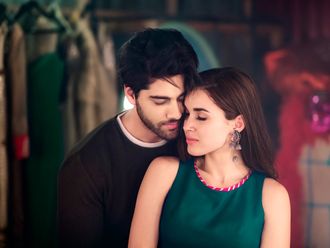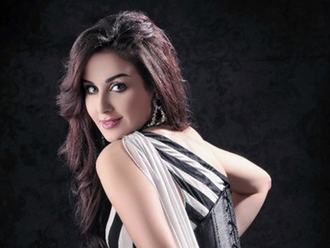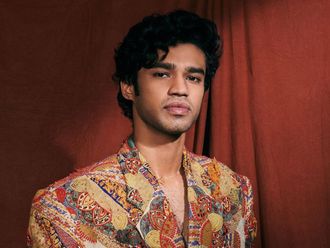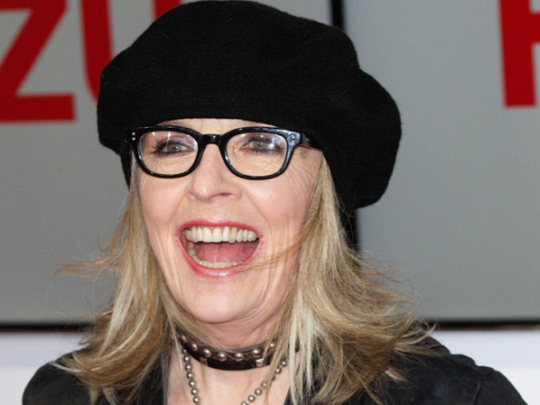
There can’t be many actors who have an off-screen persona as close to the public’s idea of them as Diane Keaton. Here she is on a sunny morning in LA in her customary uniform — dark layers of clothing, bowler hat and fishnet fingerless gloves, crosshatched with ladders — sipping tea and laughing girlishly in the Annie Hall style. She is promoting her second memoir, Let’s Just Say It Wasn’t Pretty, which she’s finding slightly painful. “It’s hard to handle it, well, in the sense of, what are you saying?” She looks vaguely around the restaurant. “Rambling and just kind of random.” At 68, Keaton looks as bemused and delighted as someone just landed from the moon.
It’s a misleading image. You don’t stay successful for decades in Hollywood — though Keaton has probably made more money from selling properties in LA than from acting — by being scatty, and it suits her to execute a style that leaves a lot of room backstage to move around in. During the interview, I will see a flash of another mode from Keaton, on the subject of Woody Allen. In the meantime, she is charming, funny, talking in long strings of non sequiturs, the punchline often self-mortification. “And I thought, oh God, I can think of nothing worse,” she says of her book, which is about beauty, a topic her editor suggested. “Too big. Too big. The concept. But as soon as I dumbed it down” — giggling — “I felt very comfortable.”
It’s not unusual for film stars to feel physically insecure. It is, however, unusual for them to delineate their shortcomings in quite so excoriating a style as Keaton’s. In this regard, she is more like a writer than an actor, taking the hit in vanity for the benefit of the joke. She describes her insecurities: her high forehead (as a teenager, she longed to look like Doris Day, but everyone said she looked like Amelia Earhart, who she thought looked like Dwight Eisenhower); the bump in her nose, which she tried to fix by sleeping with a clothes peg on it; her sunken eyes; and, her greatest bugbear, her hair — thin, lank, flyaway. She writes at length about female pattern baldness.
The irony of all this is that writing about her insecurities to this degree requires her, at some level, to be profoundly secure. “That’s a good point,” she says. “I really do think it’s to do with 20 years of being in analysis and therapy of one sort or another. You talk and you talk and you talk. So when I’m by myself, I’m just talking.”
She is still trying to figure out the anomaly of her background. On the face of it, everything seemed normal; a 1950s southern California family of four children, father a civil engineer, mother a housewife, living in a suburban house with a yard. “Beautiful mother, charming, hard-working father, who made a very good living. It all looked like that.”
But on closer inspection, Keaton says, “a bunch of eccentrics. Very extreme.” Her mother, who adored Keaton and her siblings, was, like many women of her generation, unfulfilled. “A very charming, complex, wonderful mum, who had big dreams and not really the ability to fulfil them. She would dabble in ways of getting attention, but she never had any confidence. I think she probably would have liked to have been a performer in the beginning, then an artist.”
Her father, whose interest in property speculation she inherited, was intensely critical of his daughter, whom he found worryingly unconventional. “Dad was always harping,” she writes, about her dress sense, her indecisiveness, how she ate with her mouth open. The one time he was unequivocally proud of her was when she sang Mata Hari in the Santa Ana high school production of the musical Little Mary Sunshine. A career was born.
Keaton herself was an odd mix of painfully unsure of herself and ferociously ambitious, and that pattern would continue, as would her sense of the family as a fundamentally eccentric unit. “Nobody’s normal. Normal is an absurd idea. Why even have these rules and regulations about how we’re supposed to go through life, because it’s all just ridiculous. Ridiculous.”
At the age of 50, Keaton adopted her first child, her daughter Dexter, now 18. She adopted her son, Duke, now 12, a few years later. They live in an unstarry neighbourhood in LA where they never draw the curtains, Keaton says, because she likes to let in the light. Her account of the neighbourhood is hilarious, particularly her fight with some of the neighbours. At Christmas last year, the man living opposite her rigged up his house with lights and a mechanical Santa that, at intervals, dropped its pants to reveal Merry Christmas stencilled across his buttocks. When another neighbour complained, Keaton was on the side of the Santa. “People in the suburbs,” she says, “like things covered up, and I like exposing everything.”
To a fault, Keaton finds it hard to keep anything in. The time she broke her toe by walking barefoot, backwards, because someone told her it was Zen. Her inability to stay in a relationship. Her fear of everything: dying, losing it all, flying. “I always go and talk to the captain, when I fly. I’ve come across some very different sorts of captains. Some look at me like I’m an idiot. One let me sit in the cockpit — I sat there for about half an hour and I felt good.” She’d rather stay home, but work calls, in which case it’s the only way to travel. “It’s so narrow in there, you don’t see any ground.”
Of the two big Woody Allen movies that launched Keaton’s career — Annie Hall in 1977, for which she won an Academy Award, and Manhattan two years later — her role in the former was the closest to her own personality. In Manhattan, she is cast as a pretentious, irksome snob of a journalist. In Annie Hall, she is basically herself: nervous, gauche, flighty and hilarious. The scene in which the world fell in love with her was where she and Allen, as Alvy Singer, have just played tennis and she offers him a lift home:
Alvy: Which way you going?
Annie: Me? Oh, downtown.
Alvy: Down I’m going uptown.
Annie: Oh well, you know I’m going uptown, too.
Alvy: You just said you were going downtown.
Annie: Yeah, well, but I could.
Keaton’s mumbled self-admonishments throughout the film “I don’t, I don’t, jeez, I don’t know. I wasn’t... What a jerk, yeah” — established her as a new style of heroine, touching, silly and an antidote to the polished heroines of a previous generation. She was the perfect foil to Allen’s neurosis, charming and believable.
It is a style she was still playing in 2003, in the Nancy Meyers comedy Something’s Gotta Give, in which Keaton and Jack Nicholson goofed around in a series of stunning homes in New York and the Hamptons, playing off their by then well-established personas. But Keaton can play serious, too, as she did in The Godfather films and in 1996 in Marvin’s Room, with Meryl Streep and Leonardo DiCaprio, in which she played a woman dying of leukaemia. In these roles, the modesty that plays out as hapless self-deprecation in the Allen films turns into something quieter and more subtle, and Keaton can be a deeply touching actor with a kind of stillness she seems incapable of in life. But perhaps there is more at stake in her work. For all her protestations to the contrary, one suspects she takes her acting desperately seriously; to hold one’s own onscreen alongside Al Pacino would presumably require nothing less.
Of all her leading men, Nicholson, surprisingly, is the one she’s most in contact with. Keaton has written about her affairs with Pacino, her onscreen husband in The Godfather, and Warren Beatty. She has talked extensively about her gratitude to Allen, with whom she was only briefly romantically involved. But it’s not in her constitution, she says, to be one half of a celebrity couple.
“I didn’t make the cut. Listen to me: the celebrity couple is something that was short-lived, in my case. I didn’t know how to do it. I have things about me that really do keep me in my place. I don’t know how to manage anything. As a mother, I’m not a very good manager. I don’t have a managed life. I was never meant for the big [celebrity] scene. And I belong where I am, in a place where I’m comfortable. I don’t feel comfortable with people who are very gifted and have a big life. My life — I mean, I have a lot of dreams, obviously, and I try to fulfil as many as possible. But socially, I’m not in that swing. I can’t. I don’t fit.”
There’s a little sophistry in this. Keaton writes about her relationship with Beatty breaking down not because of her inadequacy, but because of her ambition. “That became our central problem. I wanted to be Warren Beatty, not love him.”
One gets the feeling it was partly a matter of concentration; Keaton couldn’t focus for long enough to stay in pressurised relationships. “Yeah, I couldn’t pull it together,” she says. “Warren used to say to me, ‘Diane, you’d make a really good politician if you could just hang in for longer than an hour.’ He nailed it. You have to have endurance. You have to be fascinated by it.”
Celebrity didn’t fascinate her. A lot of the time, it made her want to run and hide. Or it simply left her cold. The friendship with Nicholson stuck, however — he lives up the hill from her — and they often have lunch. She finds him “extremely bright, and also really funny. I’m a really good audience. I really appreciate that.”
But Diane, I say, you’re really funny. “Not like that. It’s a different funny. These guys are very imaginative. Like Woody. And if you know them, you get to see that funny side more. They carry the burden of being so famous.”
So here we are, at the Woody Allen moment. Keaton has spoken and written about him a lot, although not since the sexual abuse allegations resurfaced last year, when Dylan Farrow, his adopted daughter with Mia Farrow, published a stark and disturbing set of allegations about Allen in the New York Times. In it, she called out Keaton, along with Allen’s other leading ladies, Cate Blanchett and Scarlett Johansson, for effectively defending Allen through their silence. “You knew me when I was a little girl, Diane Keaton,” Farrow wrote. “Have you forgotten me?” (Allen issued a detailed rebuttal of the allegations, and claimed Dylan had been indoctrinated by her mother.)
With this in mind, Keaton’s loving tribute to Allen in her book looks pointed. In one scene, she and the director walk down Madison Avenue, “like we used to”, filled with nostalgia for themselves and the city. “We didn’t hold hands, like the old days, but I swear he wore what must have been one of his beige bucket hats from Annie Hall.” It couldn’t be farther from the current image of Allen as a besieged and besmirched individual.
It seemed a calculated scene, I suggest. “It totally happened,” Keaton says. “I will never forget it. It was like the old days.”
Calculated because it seemed like a discreet act of support for him after the last six months.
“Oh, well, yes. I love him.”
You didn’t hesitate to say that publicly?
“No. No. No.” She says this sweetly. “He’s the strongest person I’ve met in my life,” she adds. “He’s made of steel. And talk about a work ethic — he’s one of the people that really did teach me that you have to work hard. But he wanted to. He’s the most disciplined person I’ve known, with the exception of my dad. But his discipline is a constant, whereas when my dad retired, I think he lost sight of what he was doing. This guy? He’s going to be practising that clarinet and touring with his band and making his one movie a year until they push him — he’s never going to stop. Who in the history of movies has done that? He’s 78, he makes a movie a year and he has total control. How is that possible?”
She smiles, as well she might. If Keaton is good at anything, it’s this kind of circumlocutory verbiage.
Did she resent being dragged into Dylan Farrow’s [New York Times] editorial?
“No. What are they going to do? Who else are they going to drag in? They have to drag someone in. I don’t resent it, not for a second.”
But the criticism Farrow aimed at her didn’t sting?
“Not really. That I didn’t know her? I saw her maybe three times. I didn’t know her. It’s not a bad accusation. I was never friends with Mia — I was friendly. Sort of like I’m friendly with you. I like you, I like the way you are. I like the way she is, too. She’s very charming. But I never knew her as a friend. A friend — that’s a commitment. It’s as close as you can get to family, and sometimes it’s even closer. Friendship requires a lot of time. I don’t have a lot of friends; I have acquaintances and people I think are charming, and I like to see them. I like to see Sarah Jessica Parker, I like to see Meryl Streep. I don’t know them — I mean, I made a movie with them, once, and that’s nice but I know nothing about their lives.”
There’s something frantic and off-topic about this. I say: Dylan Farrow’s accusation is that you publicly defended someone who molested her.
Keaton’s broad smile fixes. “I have nothing to say about that. Except: I believe my friend.”
“I used to think of myself as an attractive victim,” Keaton wrote in her first memoir, the bestselling Then Again. “A sort of sweet, misunderstood casualty.”
For years, she was bulimic, “a horrible, horrible affliction”. Looking back, she is amazed by some of the things she did or said. She remembers being 37 and encountering a woman of 50 who had just adopted a child. “And I remember thinking: that’sthe worst thing I’ve heard. Can you imagine anything more selfish? How dare she do that? She’s not fit to be doing that!” She laughs. “It’s absurd to sit around and judge like that.”
Even so, when Keaton decided to adopt, she was full of reservations. “I remembered [thinking] that’s probably too old. At 68, you’ve got to keep going for another 10 years. You’ve got to keep working; you’ve got to be responsible. You’ve got to keep participating, and being active, and showing up. My dad was 68 when he died. I turned 68 in January. Boom.”
Her new book is full of small, domestic scenes: Keaton and her children driving to school in the morning and flipping a coin to decide what radio station to have on; Keaton driving Dexter to a swimming competition or being woken up by Duke, who calls her a “creepy-ass cracker” after something he heard on TV. They are full of joy and humour, and the impression one gets is of a loving family. “It’s not easy,” she says. “It’s not. But I love them, and it was fun to write some of those incidents. Really fun.”
Did she know at the time that adopting the children was the right thing to do?
“No, I wouldn’t say I knew it was right. I wouldn’t say it was the right thing to do. I’m glad I did it. It’s right now. But then? I just thought, ‘If you don’t, who are you?’ Without having tried to do something that someone did for you? When I think what my mother did; she gave me this gift. I really, really should give it my all for somebody who doesn’t have a mother who’s going to take care of them. And it won’t be perfect, because of course it’s not.”
Getting older has its irritations, she says. She was enraged recently when a group of girls recognised her on a train in New York and mobbed her for photos, crying, “You’re so cute!” (She was already reeling from having been offered a senior ticket.) “I don’t want to be cute. ‘You’re so cute’?! For me, that’s hard.” Whereas, “’You’re odd,’ I don’t mind. Or, ‘Let me tell you about me.’ I love that.”
Keaton continues to work. She is in two forthcoming films, a Rob Reiner vehicle called And So It Goes, with Michael Douglas, and with Morgan Freeman in Life Itself. She is one of the voices in the new Disney Pixar film, Finding Dory, the sequel to Finding Nemo, due for release in 2016.
And she is building what she calls her “dream house”, which she might end up selling. Keaton has made and lost a lot of money on houses, but the thing that always scuppers her is she doesn’t know when to call it a day.
“It was only really good when I was on a budget. Because I would frequently spend so much money on, like, a kitchen, that it didn’t work out. It would be very pretty, but I made the most money on the one where I did the least. That’s the truth.” Her business manager would be tearing his hair out and “my dad would say to me, over and over, ‘Are you crazy?’”
She smiles. What can you do? People have been asking her that all her life.






